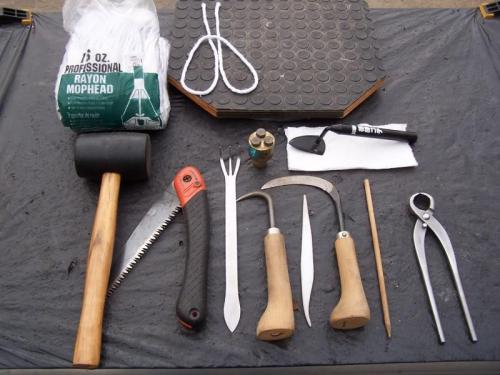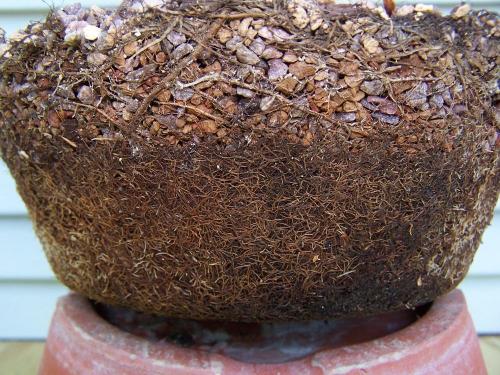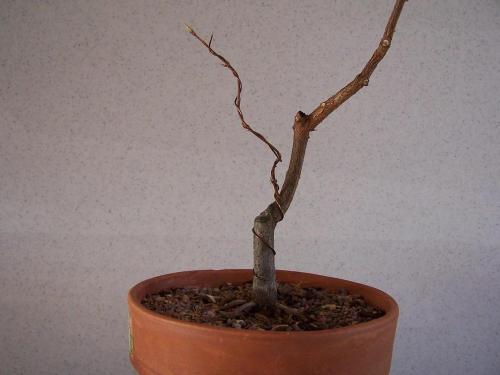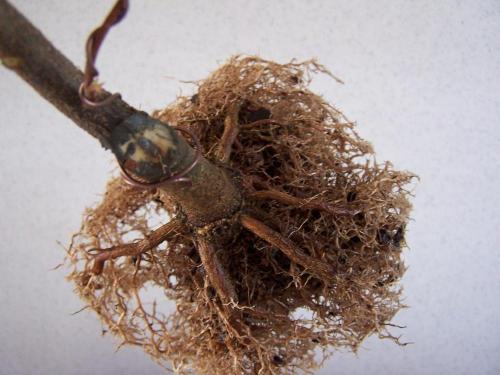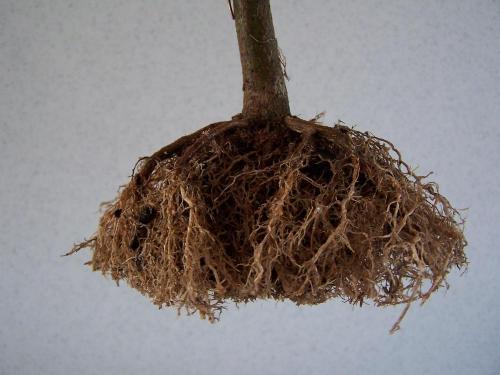My hope is that this thread becomes a gathering place for both beginners and experienced growers, a place where reliable information rooted in sound science and horticulture can be found. We will see how that 'gathering' part goes, but I have enjoyed enthusiastic participation on many of my other threads on forum sites, so I am optimistic.
I enjoy the my own growing experience tremendously. I have worked hard toward increasing my own level of proficiency for more than 30 years, and I look at sharing what I have learned about the growing sciences as a natural extension of the enjoyment I get from nurturing plants - sort of nurturing people who nurture plants. I am invited to lecture frequently in the mid-MI area, and occasionally beyond. I lecture, conduct workshops, and do demonstrations on a variety of subjects related to growing, but most frequently I talk about things related to container culture, with maintaining houseplants being one of the most requested topics.
The first challenge is to offer information that a beginner can digest, and in such a way that he or she feels it is important enough to act on. I am first going to flesh out the main issues that, if understood, will make anyone a better grower. I also hope the information is promising enough to prompt plenty of questions. For what it is worth, I tend to look at growing anything in containers from the perspective of what is best for the plant, not what is best for the grower. Far more often than not, the two perspectives are mutually exclusive because growing with proficiency does take some thought and effort.
The houseplants we grow are nearly all perennials, so they are capable of growing for many, many years, and if properly cared for could be passed down from generation to generation. With attention to the areas I will cover in this post, you will discover that you can maintain your plants in good health for as long as you are willing to continue to commit to providing favorable cultural conditions. Your plants are all genetically programmed by Mother Nature to grow well and look beautiful. It is only a lack of knowledge and skill in the area of providing the cultural conditions they prefer that prevents them from growing to their potential. That sounds harsh, but it is the truth.
I have never seen anyone other than me discuss growing plants in containers from this perspective, that is (and it bears repeating) your plants are already genetically programmed to grow well and look beautiful, but it is up to you as a grower to eliminate the limitations so often associated with growing in containers. This post is about identifying some of the cultural factors which are commonly most limiting and helping you to reduce or eliminate their limiting effects.
Soil Choice
Growers should realize that the most important choice they will make when establishing a new planting or when repotting is their choice of soil. A poor soil is probably behind more than 90% of the issues that growers come to the forums seeking remedial help for. Collapsed or dead plants, spoiled foliage, insect infestations, disease issues are all symptoms usually traceable directly or indirectly to poor root health caused by a poor soil and/or over-watering. This is so important to understand, that I will devote the bulk of my effort toward making it clear why I make this contention.
Light
is extremely important to plants. During the process of photosynthesis, plants make their own "food", using water, CO2, and energy from the sun to synthesize their food - sugar/carbohydrate. Inadequate light means the plant cannot make enough food to realize the genetic potential with which it was programmed. I will not go into great detail about light because when it comes to houseplants; you either have access to good light or are forced to deal with the limiting effects of inadequate light. If the thread finds favor, we can discuss supplementing light and how to prune to help compensate for the leggy appearance caused by insufficient light, or explore other topics of interest relating to light.
Nutritional Supplementation
is a requirement for normal growth and good health when growing plants in containers. If growing in the earth, many of the nutrients are supplied by minerals and organic components in the soil. Container soils usually have no mineral component (and it is best that they do not in most cases - more later), and the largely organic soil components break down so slowly and are washed from the soil so quickly, deficiencies are virtually assured if you do not fertilize. Choice of fertilizer is also an important consideration, as we will see.
>b>Repotting vs. Potting-Up</b>
Root congestion (being root-bound) begins to impose limitations on a plant about the point in time when the root/soil mass can be lifted from the pot intact, as a unit. From about that point forward, severity of limitations increases in a direct relationship with severity of the congestion. Commonly growers are advised to do this or that, but essentially pot up a pot size. That action, while it partially and very temporarily relieves some of the limitations associated with root congestion, ensures the worst of the congestion in the center of the root mass remains a perpetual limitation, or at best, a limitation until such time that a pair of hands actually gets into the root mass to correct the congestion and eliminate burgeoning future root problems. Repotting, which, for plants with fibrous, branching root systems that lend themselves to repotting, includes bare-rooting, root pruning, and a complete or near complete change of soil. It also ensures your plants will be completely free of the impacts of root congestion until the root system again becomes congested to the point where the root/soil mass can be lifted from the pot intact. Having completed more than 5,000 full repots, I can attest the difference in growth, health, appearance, and ability to defend themselves against diseases and insect herbivory is extreme. If a plant is well cared for and all else equal except one is potted-up the other repotted, the repotted plant will be far healthier and grow to be many times larger than its potted-up counterpart. I see it about 200 times per year.
Watering habits
are extremely important and inextricably linked to soil choice, which is why I saved it until the end of this 'short list' - so it would lead me back to the most important consideration - the one most apt to determine the difference between frustration and a rewarding growing experience.
Air is as important as water in all soils plants are to be grown in. Plants absolutely love plenty of air in the root zone, and rebel very quickly at too much water in the soil. I am going to describe what happens when you water plants growing in a soil that retains too much water. When you copiously water soils based on large fractions of fine materials like peat, coir, compost, composted forest products, sand, topsoil, ……, as you should, a layer of soil near the bottom of the container becomes 100% saturated, defies gravity, and will not drain. This layer of water has a name, it is called a 'perched water table' (PWT), so named because it 'perches' (like a bird) in the soil above the pot bottom. This excess water is critically important because it A) immediately robs roots of oxygen essential to their normal functions, and B) very quickly begins to kill fine roots growing near the bottom of the pot - within hours. The first roots to die are the roots that do the lion's share of the work - the very fine roots often referred to as 'hair roots'. The longer the soil remains saturated, the larger the diameter of the roots killed. When air finally returns to this once saturated soil, roots can only then begin to regenerate. During the cyclic death and regeneration of roots associated with excessively water-retentive soils, the plant is actually forced by chemical messengers that tell it to 'grow roots', to direct energy that would otherwise have been put toward growing more leaves, branches, blooms, fruit, or just increasing the overall mass of the plant.
If a grower is using a water retentive soil, the practice of watering in 'small sips' is often adopted so the soil remains damp instead of wet; this, to guard against limited root function and/or root rot. It makes sense to only give the plant a little water at a time so the soil never gets soggy - right? That might be a workable option if you have the luxury of using water that has been processed through a reverse osmosis water filtering system, or if you are watering with distilled water, but regular tap water has dissolved solids in it, like magnesium, calcium, iron, sulfur, and others. If you water in 'sips', these dissolved solids remain in the soil and build up over time. This has an impact on the plant's ability to absorb water and the nutrients dissolved in water. To illustrate the potential impact these dissolved solids have on a plant, picture in your mind what curing salt does to ham or bacon. It literally pulls water from the cells & dries out the meat. Any solutes (anything dissolved) in the solution surrounding plant roots can have the same potential effect on plant cells. It can make it difficult for plants to absorb water and nutrients, it can even make it impossible, and in extreme cases can actually reverse the flow of water so it moves OUT of cells, effectively collapsing and killing them. We commonly call this 'fertilizer burn', but it does not necessarily have to result from an over-application of fertilizer. When people come here wanting a remedy for foliage that is dying, with dried edges & tips, almost always it is the result of over-watering exacerbated by water-retentive soils and the accompanying limitation that has on root function/health, or as a result of the presence of a high level of dissolved solids from fertilizers and tap water having accumulated in the soil making it difficult for the plant to take up water. Both are so closely related to poor, water-retentive soils we can say the problem is inherent if not addressed directly.
Misting cannot correct a problem related to over-watering or a high level of solutes in your plant's soil. Low humidity can be a contributing factor to the common symptoms of necrotic (dead) leaf tips and margins (edges), but for the actual cause, look to impaired root function from over-watering or a high level of dissolved solids in the soil. BOTH of these conditions are nearly always linked to a poor soil. Misting raises humidity for a few minutes, but there are almost 1,500 minutes in a day. Raising humidity for 10 of the 1,500 has virtually no impact on the plant's ability to keep foliage hydrated. If you have foliage with burned leaf tips and margins, you should look to the soil and the state of root health for the cause.
When using water-retentive soils, it seems almost as though we are on the horns of a dilemma. If we water generously, we risk the soil remaining saturated so long it causes root rot, or at a minimum - impaired root function. If we water sparingly, in small sips, we risk an accumulation of dissolved solids from tap water and fertilizer solutions in the soil - so what to do? Well – why worry about being on the horns of a dilemma when we can eliminate the bull? Let's look at an option that solves both issues and makes things much easier for the grower, while also providing the grower with considerably more latitude when it comes to watering and fertilizing.
The factor that determines how water retentive and difficult a soil is to grow in, is the size of the particles it is made from. The smaller the particles - the greater the water retention and the greater the degree of difficulty for growers. Soils made of any combination of peat, coir, compost, sand, topsoil, and other fine particulates are going to be very water retentive, which we know is undesirable from the perspective of the plant, and they cannot be suitably amended to correct drainage or the height of the perched water by adding perlite or other drainage material. If anyone disagrees with that statement, please ask for an explanation before mounting an argument or offering individual observations.
Soils made of a high % of pine bark or other coarse inorganic particles will have plenty of large air spaces called macropores. These are pores that will not hold water, only air, even when the soil is as saturated is it can be (this state is called container capacity). They are critical to a healthy root zone. If you build a soil with plenty of air space, it hardly matters what the soil is made from. What is important is how the soil is structured. I will grow a perfectly healthy plant in a bucket of broken glass on a dare and a wager if anyone is interested in taking me up on it. If you have a soil with a healthy structure, a good nutritional supplementation program, and have good available light, the rest is so easy anyone can do it - honest. I have seen it happen over & over and over again. You will not go wrong if your primary focus is providing a healthy - a truly healthy environment for roots. Roots are the heart of the plant. Roots come first. If you cannot keep the roots happy, there is no chance you can keep the rest of the plant happy. That was a paraphrased quote from Dr. Carl Whitcomb, PhD, who wrote the bible on "Plant Production in Containers".
This ends the beginning discussion about soils. Until you are able to grow plants, the growth rate and appearance of which you are happy with, focusing on removing the limitations placed on your plants by soil choice will almost always constitute the best use of your energies. After reading this far, if nothing else, I hope you take that concept from this offering. It is the most important point and the best piece of advice I can give you. If you are interested in knowing HOW to make soils that will help you remove the limitations, now is the time to ask.
Nutrition
is an area that is very misunderstood when it comes to container culture, but it is actually very easy. It is also very easy to become confused because there are so many numbers that represent different fertilizer NPK percentages and so many different kinds of fertilizers. I will need to use some numbers, but I think an understanding of NPK percentages as opposed to fertilizer RATIOS is important. NPK %s tell us how much (N)itrogen, (P)hosphorous pentoxide, and (K) potassium oxide (the symbol for potassium is 'K') are in a fertilizer by weight. So a fertilizer that is labeled "All Purpose 24-8-16" is 24% nitrogen, 8% phosphorous pentoxide, and 16% potassium oxide. 12-4-8 is also a common "all-purpose" fertilizer. It has exactly half the nutrients of 24-8-16, but both are 3:1:2 RATIO fertilizers. Ratios are a way of describing the amount of nutrients in a fertilizer as they relate to each other. Why is this important? It is important because we know that on average, plants use about 6 times as much N as P, and they use about 3/5 as much K as N, and now I will tell you how we can use this information to our plant's advantage.
The ideal way to fertilize is to supply fertilizer at the same ratio in which plants use the nutrients. The reason is because optimal growth and vitality can be had only when nutrients are in the soil at overall levels low enough that it does not become difficult for plants to take up water and nutrients dissolved in that water. Remember what we said above about a high level of dissolved solids (salts) in the soil making it difficult for roots to absorb water and nutrients? Nutrients also need to be present at levels high enough to prevent deficiencies. If we think about it for a second, we can see that the best way to achieve this end is to supply nutrients at the same ratio in which they are used.
I noted that the NPK percentages actually tell us how much phosphorous pentoxide and potassium oxide are in a fertilizer so I can show you how fertilizer manufacturers arrived at a 3:1:2 ratio as their "all-purpose" blend. Only 43% of the P reported on a fertilizer label is actually P, and only 83% of the K reported is actually K. Once you apply these factors to any of the 3:1:2 ratio fertilizers (24-8-16, 12-4-8, and 9-3-6 are all popular 3:1:2 ratios), you will see they supply nutrients in almost exactly the same ratios as the average that plants actually use, and these fertilizers are excellent at keeping the overall level of solubles as low as they can be without creating nutritional deficiencies.
I use Dyna-Gro's Foliage-Pro 9-3-6. It's by far the best fertilizer I've found for containers, and I'm always paying attention for something better. There is no need to use 'specialty' fertilizers; and many specialty fertilizers, like the advertised "bloom boosters" with up to 30 times more phosphorous than a plant could ever use (in relation to the amount of N used), can be (almost always are) moderately to severely limiting because an excess of any nutrients individually or in combination with others nutrients has only the potential to be limiting.
The question often arises, "Should I use a synthetic or an organic fertilizer"? The answer is: "Use whichever you wish"; but the qualifiers are: Organic fertilizers are actually more accurately called soil amendments. They are mixed into the soil in the hope that at some point soil organisms will digest them and make them available in a form plants can absorb. The problem with that approach is the population count and activity levels of soil life in containers are erratic and unreliable, making the delivery of nutrients from organic sources just as erratic and unreliable. What you apply today, may not be available until next month, and there is no way to determine what residual amounts of which elements remain in the soil. Soluble fertilizers like Miracle-Gro, Foliage-Pro and others, are completely available as soon as applied, and we know exactly what our plants are getting. They are simply much easier to use and deliver nutrients much more reliably than other fertilizer types. You can lump controlled release fertilizers like Osmocote and others in with the soluble synthetic fertilizers. With them, you get an extra measure of convenience but sacrifice a measure of control. As with all fertilizers, it is important to note the NPK percentages to be sure you are supplying the fertilizer in a favorable ratio if you want your plants to be all they can be.
When it comes right down to what occurs at the molecular/cellular levels, plants take up nutrients in ionic form. They cannot absorb the nutrients that are locked in the hydrocarbon chains that make up organic fertilizers until the molecules are broken down into a simpler form. At that point, all nutrients are taken up in the same form, no matter if they came from compost, a dead fish, or a hose end sprayer. Plants could care less where their nutrients come from, as long as they have a constant supply of all essential nutrients at all times.
It is not going to kill your plants if you use a fertilizer with a less than favorable ratio because plants tend to take the nutrients they need from the soil (solution) and leave the rest, but it is important to understand that it is 'the rest' that constitutes a limiting factor; so avoiding unnecessarily high levels of any one nutrient or nutrients whenever possible is to your (plant's) benefit.
It is important to understand that growing in containers is markedly different than growing in gardens. On a scale of 1-10, with 1 being growing in the garden and 10 being hydroponics, gardening in containers is much closer to hydroponics than gardens, getting a rating of somewhere around 7 or 8. This is why many of the practices that serve us so well in our gardens do not work well in containers. One area that is often a sticking point is the idea we need to "feed the soil". While that is an admirable and productive approach to gardening in the earth, container soils are more about their structure than about any nutrients they might supply. If you concentrate on your soils structure and durability of that structure, and more specifically the soil's ability to hold plenty of air, you will greatly increase both the probability of consistent success and the margin for grower error. Well-aerated soils are easier to grow in and offer much greater opportunity for plants to grow as near to their potential as possible.
As noted above, most growers draw no distinction between 'repotting' and 'potting up'. I have spent literally thousands of hours digging around in the root-balls of containerized plants. Old plants from nurseries or greenhouses are probably the closest examples to what most houseplants are like below the soil line, so I'll offer my thoughts for you to consider or discard as you find fitting.
I have also helped salvage many plants that had been containerized for long periods and were 'circling the drain'. Illustration: Not long ago, our bonsai club invited a visiting artist to conduct a workshop with mugo pines. The nursery (a huge operation) where we have our meetings happened to have purchased several thousand of the mugos somewhere around 10 - 12 years prior and they had been potted up into continually larger containers ever since. Why relate these uninteresting snippets? In the cases of material that has been progressively potted-up only, large perennial roots occupied nearly the entire volume of the container, plant vitality was in severe decline, and soil in the original root-ball had become so hard that in some cases a chisel was required to remove it.
In plants that are potted up, rootage becomes entangled. As root diameters increase, portions of the roots constrict other roots and impair the flow of water and nutrients through them, much the same as in the case of girdling or encircling roots on trees grown in-ground. The ratio of fine, feeder roots to more lignified (woody) and perennial roots becomes skewed to favor the larger, and practically speaking, useless roots.
The initial symptoms of poor root conditions are progressive diminishing of branch extension on plants that branch, loss/shedding of foliage on the parts of branches nearest to the main stems or trunk, often giving the plant a 'poodle look', and reduced vitality. As rootage becomes continually compressed and restricted, branch extension stops and individual branches might die as water/nutrient movement is further compromised. Foliage quality may not (important to understand) indicate the tree is struggling until the condition is severe, but if you observe your plants carefully, you will find them increasingly unable to cope with stressful conditions - too much/too little water, heat, sun, etc. Plants operating under conditions of stress that has progressed to strain, will usually be diagnosed in the end as suffering from attack by insects or other bio-agents/disease while the underlying cause of root congestion goes unnoticed.
I will mention again that I draw distinct delineation between simply potting up and repotting. Potting up temporarily offers room for fine rootage to grow and do the necessary work of water/nutrient uptake, but these new roots soon lignify, while rootage in the old root mass continues to grow and become increasingly restrictive. The larger and larger containers required for potting-up & the difficulty in handling them also makes us increasingly reluctant to undertake even potting up, let alone undertake the task of repotting/root-pruning, which grows increasingly difficult with each up-potting.
So we are clear on terminology, potting up simply involves moving the plant with its root mass and soil intact, or nearly so, to a larger container and filling in around the root/soil mass with additional soil. Repotting, on the other hand, includes the removal of all or part of the soil and the pruning of roots, with an eye to removing the largest roots, as well as those that would be considered defective. Examples are roots that are dead, those growing back toward the center of the root mass, straight up, straight down, encircling, girdling or j-hooked roots, and otherwise damaged roots.
I often explain the effects of repotting vs potting up like this:
I will rate growth/vitality potential on a scale of 1-10, with 10 being the best. We are going to say that plants in containers can only achieve a growth/vitality rating of 9, due to the somewhat limiting effects container culture has on all plants. Lets also imagine that for every year a plant goes w/o repotting or potting up, its measure of growth/vitality slips by 1 number, That is to say you pot a plant and the first year it grows at a level of 9, the next year, an 8, the next year a 7. Also imagine please, we're going to go 3 years between repotting or potting up, which is how the illustration is structured.
Here's what happens to the plant you repot/root prune:
year 1: 9
year 2: 8
year 3: 7
repot
year 1: 9
year 2: 8
year 3: 7
repot
year 1: 9
year 2: 8
year 3: 7
You can see that a full repotting and root pruning returns the plant to its full potential within the limits of other cultural influences for as long as you care to repot/root prune.
Looking now at how woody plants respond to only potting up:
year 1: 9
year 2: 8
year 3: 7
pot up
year 1: 8
year 2: 7
year 3: 6
pot up
year 1: 7
year 2: 6
year 3: 5
pot up
year 1: 6
year 2: 5
year 3: 4
pot up
year 1: 5
year 2: 4
year 3: 3
pot up
year 1: 4
year 2: 3
year 3: 2
pot up
year 1: 3
year 2: 2
year 3: 1
This is a fairly accurate illustration of the influence tight roots have on a plant's growth/vitality. You might think of it for a moment in the context of the longevity of bonsai trees vs the life expectancy of most trees grown as houseplants, or the difference between less than 4 years versus more than 400 years, lying primarily in how the roots are treated.
I have not yet mentioned that the dissimilar characteristics of the old soil as compared to the new soil when potting-up; and the potential mixing of dissimilar soils in the same container are also a recipe for trouble. With a compacted soil in the old roots and a fresh batch of soil surrounding the roots of a freshly potted up plant, it is nearly impossible to establish a watering regimen that doesn't keep the differing soils either too wet or too dry, both conditions occurring concurrently being a limiting factor and the rule rather than the exception.
Most who read this would have great difficulty showing me a containerized plant that is more than 10 years old and as vigorous as it could be, unless it has been root-pruned at repotting time; yet I can show you hundreds of trees 20 years to 200 years old and older, and many of my very old houseplants/succulents that are in perfect health. All have been root-pruned and given a fresh footing in new soil at regular and frequent intervals, the same treatment all my houseplants get.
Thanks to any/all who made it this far. This is only an overview, but with even a rudimentary understanding of how to go about reducing the effects of the limiting factors that restrict growth and vitality, I know you can improve on how well your plants can grow, as well as on the degree of satisfaction you get from your growing experience - my only reasons for writing this. Hopefully the offering leaves you with many questions.
Al
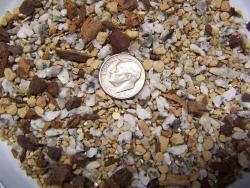 which is almost incapable of holding water in spaces between soil particles, you can start a tiny seed in a 55 gallon drum of soil w/o risking over-watering; whereas, when using a water-retentive medium, the seed would be at risk of perishing in only a cup of soil.
which is almost incapable of holding water in spaces between soil particles, you can start a tiny seed in a 55 gallon drum of soil w/o risking over-watering; whereas, when using a water-retentive medium, the seed would be at risk of perishing in only a cup of soil. 